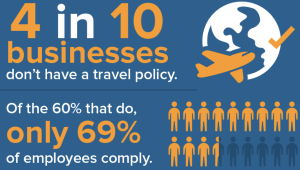Business travel – it seems – is back.

Source: Global Business Travel Association
It’s four years since the first Covid-19 lockdowns brought business travel to its knees, and ushered in the new normal of meetings via Zoom/Teams – a development which some thought could dent business travel permanently.
But new data suggests that while the days of traveling long distances for one meeting with one person could well be gone forever, people ‘are’ returning to travel for business at scale.
New data from the Global Rescue Winter Traveler Sentiment and Safety Survey shows that business travel is on the increase post-pandemic, while virtual meetings are losing their dominance.
According to the survey, numbers traveling for business jumped 37% compared to the same survey nearly a year ago.
More than a fifth of business travelers (22%) predict work-related travel will exceed pre-pandemic levels during 2024 – which is double the 11% reported in 2023.
This time last year, 35% of business travelers said business travel would be “half or less than half” of pre-pandemic levels.
Now, a year later, that percentage has dropped by a third with only 23% of business travelers reporting that their work-related travel would be half or less than pre-pandemic levels.
In addition to all this, more than two-thirds (68%) of respondents said their business travel would be both international and domestic.
Virtual meetings ‘have their place’ but can’t replicate in-person meetings
Respondents clearly feel there is no substitute for business travel when it comes to establishing and maintaining relationships, and that virtual meetings, though they serve a purpose, are never going to replace in-person conversations.
On the remote meetings side of things, more than half (56%) of business travelers responding to the survey said virtual meetings and video conferences “are not” replacing in-person business travel to a significant extent.
Respondents were clear: Virtual meetings have their place. But they can’t replace face-to-face meetings. Personal interaction, they felt, will always be more effective at establishing and maintaining relationships, fostering trust and driving company growth.
And they’re probably right.
You can’t get to know a prospect, current client or business partner professionally and personally when you’re not in person.
In a video chat, there is more opportunity for distraction and multitasking. The meetings themselves can feel rushed, and the technology can sometimes glitch.
That’s not how you maintain a strong business relationship that lasts. In-person interaction is.
Here are some of the other highlights of the research:
- The overwhelming majority of respondents (93%) are planning international trips this year
- Some 41% of respondents say they’re planning three or more trips and more than half (52%) are taking one-to-two trips abroad.
- Mexico, Canada, Europe and Africa are the four leading international destinations for travelers, according to survey results.
- A significant number of survey respondents (66%) are planning to include new international destinations to visit this year.
- Nearly a quarter (23%) of respondents said that since the pandemic ended, they are planning to stay longer on at least one of their international trips in 2024.
- One in five respondents (21%) are planning more adventurous, immersive trips in 2024 compared to past trips.
- Nearly a third (30%) said some of their trips would be solo, with 19% saying at least one trip would be on their own. Some 8% said one or more trips would be travel with business colleagues.
But…CHRO’s must look at safety again

Source: Egencia, Travelport
It stands to reason that as business travel increases, so do challenges facing employers who must balance employee safety.
The biggest management challenge in this evolving environment will be how duty of care plays a role in protecting a business traveler and a location-independent workforce.
Business leaders will now have to remind themselves if adequate rules or policies designed to maintain the health, safety and wellbeing of their employees are in place.
Unfortunately, the overwhelming majority of business travelers surveyed (74%), said they didn’t have or did not know if they have a duty of care policy in place.
The majority of the 26% of business travelers who said they do have duty of care provisions in place reported the policy includes pre-trip planning, health alerts, on-trip event alerts, on-trip security or travel tracking.
Business leaders carry a duty of care responsibility to their employees, to take care of them and avoid exposing them to any unnecessary or undue risk.
Most business travelers lack immediate access to travel intelligence information or communication capabilities that may be lifesaving in the event of a medical or security emergency.
As global work-related travel continues to increase, the more duty of care policies must evolve.
The survey showed that one thing remains constant: the irreplaceable value of face-to-face meetings.
The return of those in-person meetings is something we should all embrace, not just as a tradition, but as a testament to the enduring importance of the genuine human connection that will shape the future of business.
